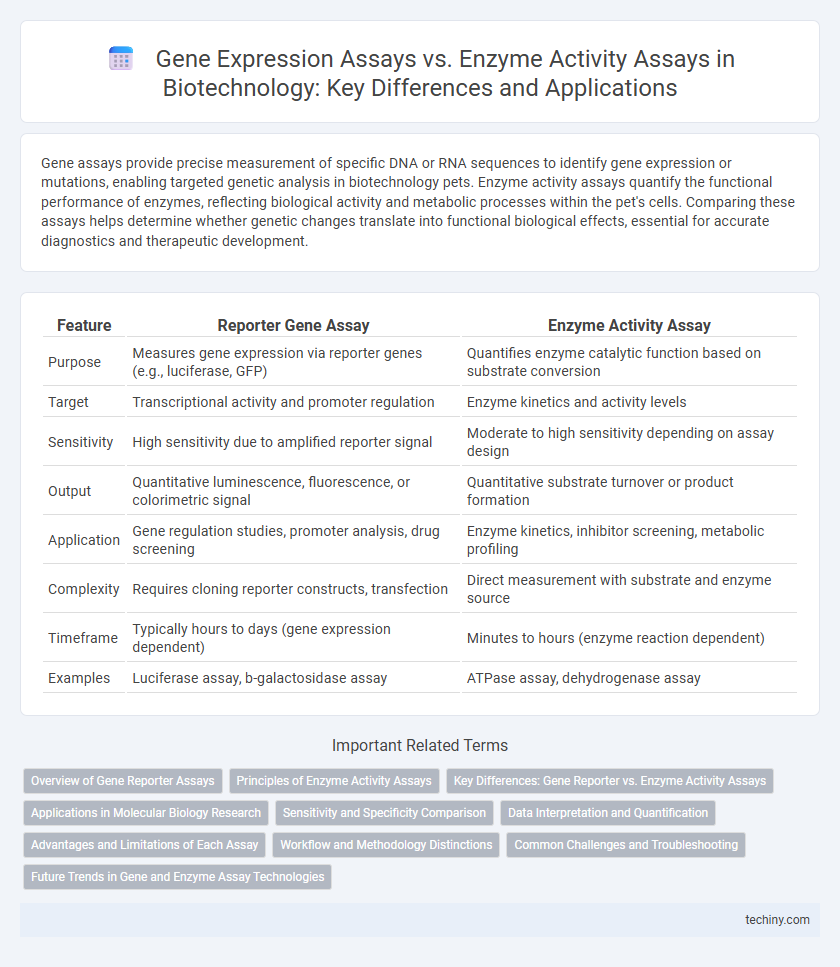Gene assays provide precise measurement of specific DNA or RNA sequences to identify gene expression or mutations, enabling targeted genetic analysis in biotechnology pets. Enzyme activity assays quantify the functional performance of enzymes, reflecting biological activity and metabolic processes within the pet's cells. Comparing these assays helps determine whether genetic changes translate into functional biological effects, essential for accurate diagnostics and therapeutic development.
Table of Comparison
| Feature | Reporter Gene Assay | Enzyme Activity Assay |
|---|---|---|
| Purpose | Measures gene expression via reporter genes (e.g., luciferase, GFP) | Quantifies enzyme catalytic function based on substrate conversion |
| Target | Transcriptional activity and promoter regulation | Enzyme kinetics and activity levels |
| Sensitivity | High sensitivity due to amplified reporter signal | Moderate to high sensitivity depending on assay design |
| Output | Quantitative luminescence, fluorescence, or colorimetric signal | Quantitative substrate turnover or product formation |
| Application | Gene regulation studies, promoter analysis, drug screening | Enzyme kinetics, inhibitor screening, metabolic profiling |
| Complexity | Requires cloning reporter constructs, transfection | Direct measurement with substrate and enzyme source |
| Timeframe | Typically hours to days (gene expression dependent) | Minutes to hours (enzyme reaction dependent) |
| Examples | Luciferase assay, b-galactosidase assay | ATPase assay, dehydrogenase assay |
Overview of Gene Reporter Assays
Gene reporter assays utilize genetically engineered constructs to measure the expression of target genes by linking regulatory sequences to easily quantifiable reporter genes such as luciferase, GFP, or b-galactosidase. These assays provide real-time, sensitive detection of transcriptional activity, enabling the study of promoter function, signal transduction pathways, and gene regulation mechanisms at the genetic level. In contrast to enzyme activity assays that quantify enzymatic reactions directly, gene reporter assays reflect upstream gene expression changes, offering insight into transcriptional regulation and cellular response dynamics.
Principles of Enzyme Activity Assays
Enzyme activity assays measure the catalytic function of enzymes by quantifying substrate conversion rates under controlled conditions, providing direct insights into enzyme kinetics and functional state. These assays rely on detecting changes in absorbance, fluorescence, or product formation, enabling precise evaluation of enzyme efficiency and inhibition. Unlike gene assays that assess gene expression levels, enzyme activity assays focus on functional protein outputs critical for metabolic and regulatory pathway analyses.
Key Differences: Gene Reporter vs. Enzyme Activity Assays
Gene reporter assays measure the expression of specific genes by quantifying reporter gene products such as luciferase or GFP, providing insights into transcriptional activity and promoter function. Enzyme activity assays directly evaluate the catalytic function of enzymes by measuring substrate conversion rates or product formation, reflecting functional enzymatic performance. The main difference lies in gene reporter assays assessing gene expression indirectly through reporter proteins, while enzyme activity assays focus on the biochemical activity of native enzymes.
Applications in Molecular Biology Research
Gene assays precisely quantify nucleic acid sequences to analyze gene expression patterns and mutations, enabling insights into transcriptional regulation and genetic variations. Enzyme activity assays measure catalytic functions of enzymes to assess biochemical pathways, protein function, and metabolic states within cells. Both assays provide complementary data in molecular biology research, with gene assays targeting genetic information and enzyme activity assays focusing on functional protein analysis.
Sensitivity and Specificity Comparison
Gene assays offer higher sensitivity by detecting low-abundance nucleic acid sequences with precision, enabling early biomarker identification in biotechnology applications. Enzyme activity assays provide superior specificity by directly measuring enzymatic function, reflecting real-time biological activity more accurately. Balancing these assays' sensitivity and specificity is crucial for robust biotechnological analyses and diagnostic tool development.
Data Interpretation and Quantification
Gene assays provide quantitative data by measuring nucleic acid levels, enabling precise interpretation of gene expression changes at the molecular level. Enzyme activity assays quantify the functional output of enzymes through substrate conversion rates, reflecting actual biochemical activity rather than gene transcription alone. Combining gene assay data with enzyme activity measurements ensures a comprehensive understanding of both genetic regulation and enzymatic function, enhancing the accuracy of biological interpretations.
Advantages and Limitations of Each Assay
Gene assays provide precise quantification of gene expression levels, enabling detection of transcriptional changes with high sensitivity, but they do not directly measure functional protein activity, which may lead to incomplete functional insights. Enzyme activity assays offer direct measurement of catalytic function, reflecting the actual biochemical activity of the enzyme in physiological conditions, yet they can be limited by substrate specificity and interference from complex biological matrices. Combining gene assays with enzyme activity assays enhances comprehensive understanding by correlating gene expression with functional enzymatic outcomes, balancing sensitivity with functional relevance.
Workflow and Methodology Distinctions
Gene assays primarily analyze nucleic acid sequences to measure gene expression or genetic variations, employing techniques such as PCR, microarrays, or RNA sequencing. Enzyme activity assays quantify catalytic function by monitoring substrate conversion rates using spectrophotometry, fluorometry, or chromogenic substrates. Workflow distinctions include nucleic acid extraction and amplification in gene assays versus substrate incubation and product detection in enzyme assays, each requiring specific optimization for accurate quantification.
Common Challenges and Troubleshooting
Gene assays and enzyme activity assays commonly face challenges such as sample degradation, non-specific binding, and variability in assay conditions, which can compromise data accuracy and reproducibility. Troubleshooting often involves optimizing lysis buffers, adjusting incubation times, and validating controls to minimize background noise and enhance signal specificity. Implementing rigorous standardization protocols and employing fresh reagents are critical to overcoming inconsistencies in experimental outcomes for both assay types.
Future Trends in Gene and Enzyme Assay Technologies
Emerging innovations in gene and enzyme assay technologies emphasize high-throughput capabilities and enhanced sensitivity through microfluidics and nanotechnology integration. Advances in CRISPR-based diagnostics and single-molecule enzyme assays are driving precision and real-time monitoring in personalized medicine. Machine learning algorithms are increasingly applied to assay data interpretation, optimizing assay design and accelerating biomarker discovery in biotechnology research.
**Report gene assay vs Enzyme activity assay** Infographic

 techiny.com
techiny.com